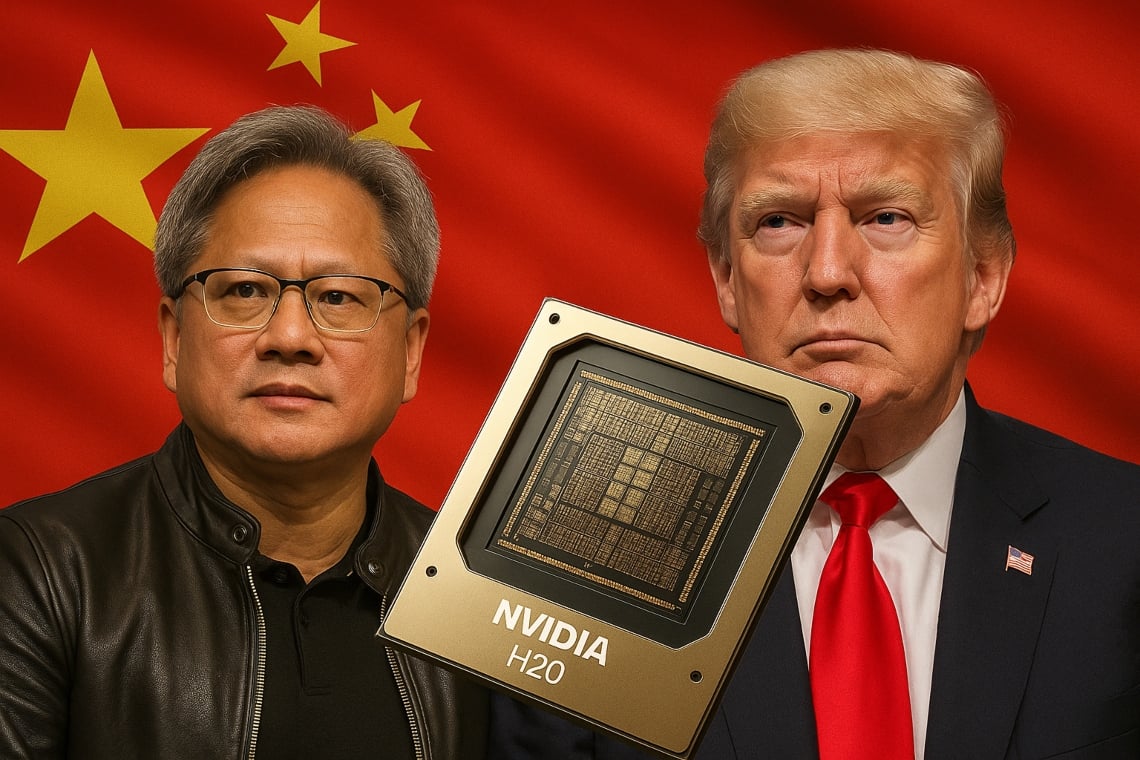After months of uncertainty and export blocks, Nvidia announces the resumption of sales of its AI H20 chips in China.
The decision comes in the wake of a crucial meeting between CEO Jensen Huang and President Donald Trump at the White House, during which the company obtained fundamental reassurances: export licenses for the chips will finally be granted.
This is news that marks a significant turning point for Nvidia, which had seen its access to one of the world’s most important markets severely compromised by the restrictions imposed by the Trump administration.
Recovery of AI chip sales in China: an anticipated breakthrough
The news of the recovery of sales in China had an immediate and disruptive effect on the financial markets.
The Nvidia shares soared over 5% in pre-market trading, confirming investors’ confidence in the company’s ability to resume its global expansion.
Just a few days earlier, Nvidia had reached a historic milestone, becoming the first public company to surpass a market valuation of 4 trillion dollars.
This achievement underscores the company’s dominant role in the field of artificial intelligence and its strategic importance in the global economy.
According to Daniel Ives, senior analyst at Wedbush Securities, this decision represents “a watershed moment for Nvidia, the thesis of the artificial intelligence revolution and the US tech industry in general.”
Ives described the resumption of exports as “a monstrous victory for the godfather of artificial intelligence Jensen and Nvidia.”
Specifically highlighting how the return of China among the company’s reference markets is set to positively influence Wall Street’s growth estimates for the years to come.
In April, Nvidia was forced to suspend shipments of the H20 chips, a decision that resulted in $4.5 billion in inventory write-downs and an estimated loss of $2.5 billion in expected sales. The block was imposed by the Trump administration as part of the new trade measures known as “Liberation Day,” which required a license for the export of sensitive technologies to China.
This interruption not only damaged Nvidia’s revenues but also offered Chinese competitors a valuable opportunity to bridge the technological gap in the race for AI.
The strategic role of H20 chips
The H20 chip was specifically designed to comply with previous export controls to China. Now, with new licenses on the way, Nvidia anticipates a significant increase in revenue in the second half of 2025.
Meanwhile, according to a report by Reuters in May, the company was preparing to launch a new AI chip in China based on the RTX Pro 6000D, featuring lower specifications and a more accessible price compared to the H20, to meet the needs of a rapidly evolving market.
China represents a fundamental slice of Nvidia’s business. In the fiscal year ended January 26, the Chinese market generated $17 billion in revenue, equal to 13% of the company’s total sales.
It is therefore not surprising that Nvidia has lobbied to reintegrate China into its supply chain, despite geopolitical tensions and concerns raised by some members of the American Congress.
During his institutional visits, Jensen Huang reiterated that the world is at a turning point: artificial intelligence is now a fundamental resource, on par with energy, water, and the Internet.
Huang emphasized Nvidia’s support for open source research, foundational models, and applications that “democratize artificial intelligence” and promote the development of emerging economies.
According to the CEO, “generic and open-source research and foundational models are the backbone of artificial intelligence innovation.”
Huang also stated that every civil model should perform optimally on the U.S. technology stack, thus encouraging nations around the world to choose America as a technology partner.
Nvidia: undisputed leader of AI hardware
The enthusiasm of investors reflects Nvidia’s dominant position in the AI hardware market, where the company holds an estimated 97% share in the GPU accelerator segment.
These powerful chips are essential for accelerating the complex tasks required by training artificial intelligence systems, working in synergy with traditional processors and playing a role similar to that of a turbocharger in a car engine.
Nvidia’s leadership in this sector is one of the main drivers of the global artificial intelligence boom.
As Nvidia prepares to strengthen its presence in China, major competitors like AMD and Intel are also accelerating the development of new solutions to meet the growing Chinese demand for AI technologies.
This competition promises to exert further pressure on both regulatory authorities and global suppliers, fueling a race for innovation that will have worldwide repercussions.
The resumption of AI chip exports to China marks a new chapter in the history of Nvidia and the entire tech industry.
The decision of the Trump administration to grant the licenses represents not only a victory for the company, but also a signal of the strategic centrality of artificial intelligence in the geopolitical and economic dynamics of the future.
With China back in the game, Nvidia is preparing to consolidate its global leadership, while the world witnesses a new phase of the AI revolution.
